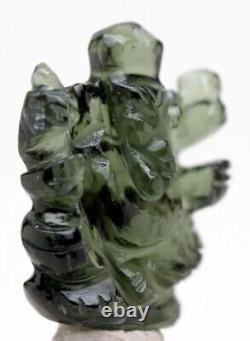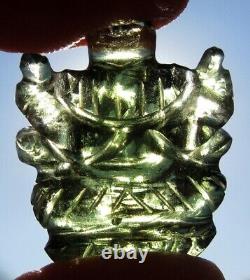MOLDAVITE GANESHA Ganesh Meteorite Impact Glass Gemstone Tektite HINDU Carving








This high quality moldavite carving weighs 2.33 grams. It measures 19 mm by 17 mm x 7 mm. This is a spectacular hand carved moldavite Ganesh.
If you don't know what moldavite is well then, get ready to be amazed! This is the product of an ancient meteorite impact 15 million years ago, in the middle of what is now the Czech Republic. The earth at the impact site was turned molten by the impact and thrown into the atmosphere, cooling as it fell and solidifying into this beautiful, glassy green tektite. It is highly collectible and more and more rare all the time. It is getting more difficult to find, especially in pieces as clear and high quality as this one. This is a newly viral phenomenon going on about this super magical and powerful gemstone. This newly viral sensation has caused the value of moldavite to go up around 10 fold in one year alone!Not only has it caused the cost to increase greatly, it has also caused this highly popular gemstone to also be harder and harder to find and get your hands on. It is making it very very hard to find any at all anymore. It's practically impossible to find any at all anymore.
So it's going to soon be impossible to find this interesting and fascinating mineral. For now there is a little left and what is left is a complete fortune! For more info about this mineral and it's formation I will add excerpts from a Wikipedia article below.
The IMCA is a highly prestigious organization that is even difficult to attain membership in, and it is guarantees the genuineness and authenticity of meteorites and meteorite related items that I sell. This is a very tight-knit community made up of meteorite hunters, dealers, collectors, and scientists who look out for each other to make sure that the meteorites offered to the public are authentic and genuine. If you have any questions, do not hesitate to ask me.Thanks so much for visiting my listing and have a great day! Moldavite (Czech: vltavín) is a forest green, olive green or blue greenish vitreous silica projectile glass formed by a meteorite impact in southern Germany (Nördlinger Ries Crater)[3] that occurred about 15 million years ago. [4] It is a type of tektite. Moldavite was introduced to the scientific public for the first time in 1786 as "chrysolites" from Týn nad Vltavou in a lecture by Josef Mayer of Prague University, read at a meeting of the Bohemian Scientific Society (Mayer 1788).
Zippe (1836) first used the term "moldavite", derived from the Moldau (Vltava) river in Bohemia (the Czech Republic), from where the first described pieces came. In 1900, Franz Eduard Suess pointed out that the gravel-size moldavites exhibited curious pittings and wrinkles on the surface, which could not be due to the action of water, but resembled the characteristic markings on many meteorites.
He attributed the material to a cosmic origin and regarded moldavites as a special type of meteorite for which he proposed the name of tektite. Moldavites' highly textured surfaces are now known to be the result of pervasive etching by naturally occurring CO2 and humic acids present in groundwater. [6] Because of their extremely low water content and chemical composition, the current consensus among earth scientists is that moldavites were formed about 14.7 million years ago during the impact of a giant meteorite in the present-day Nördlinger Ries crater. Splatters of material that was melted by the impact cooled while they were actually airborne and most fell in Bohemia.
Currently, moldavites have been found in an area that includes southern Bohemia, western Moravia, the Cheb Basin (northwest Bohemia), Lusatia (Germany), and Waldviertel (Austria). [7] Isotope analysis of samples of moldavites have shown a beryllium-10 isotope composition similar to the composition of Australasian tektites (australites) and Ivory Coast tektites (ivorites).
Most moldavites are from South Bohemian localities, with just a few found in South Moravian localities. Rare moldavites have been found in the Lusatian area (near Dresden), Cheb basin area (West Bohemia) and Northern Austria (near Radessen). Principal occurrences of moldavites in Bohemia are associated with Tertiary sediments of the Ceské Budejovice and Trebon basins.
The most prominent localities are concentrated in a NW-SE strip along the western margin of the Ceské Budejovice Basin. The majority of these occurrences are bound to the Vrábce Member and Koroseky Sandy Gravel. Prominent localities in the Trebon Basin are bound to gravels and sands of the Domanín Formation.
In Moravia, moldavite occurrences are restricted to an area roughly bounded by the towns of Trebíc, Znojmo and Brno. The colour of Moravian moldavites usually differs from their Bohemian counterparts, as it tends to be brownish. Taking into account the number of pieces found, Moravian localities are considerably less productive than the Bohemian ones; however, the average weight of the moldavites found is much higher. The oldest (primary) moldavite-bearing sediments lie between Slavice and Trebíc. The majority of other localities in southern Moravia are associated with sediments of Miocene as well as Pleistocene rivers that flowed across this area more or less to the southeast, similar to the present streams of Jihlava, Oslava and Jevisovka.
The chemical formula of moldavite is SiO2(+Al2O3). Its properties are similar to those of other types of glass, and reported Mohs hardness varies from 5.5[1] to 7. [2] Moldavite can be transparent or translucent with a mossy green color, with swirls and bubbles accentuating its mossy appearance. Moldavites can be distinguished from most green glass imitations by observing their worm-like schlieren. Moldavites were discovered by prehistoric people in the Czech Republic and Austria and were used to make flaked tools. Some of the worked moldavites date to the Aurignacian period of the Upper Paleolithic, approximately 43,000 to 26,000 years before the present. In the modern world, moldavites are often used, rough or cut, as semi-precious stones in jewelry. They have purported metaphysical qualities and are often used in crystal healing. There is the Moldavite Museum in Ceský Krumlov, Czech Republic. [10] The Moldavite Association was established in Ljubljana, Slovenia in 2014.The association researches, exhibits and promotes moldavites and other tektites around the world and has member geologists from more than 30 countries worldwide. Many people consider moldavite to have come to Earth to help the planet rise above its current state. This is why moldavite is used heavily for healing rituals of the earth chakra.
In addition, moldavite is a good stone that is used for those who want to magnify the vibrations of their other types of crystals. There are claims that moldavite possesses metaphysical properties as if you gaze into a more translucent piece of the gemstone while you're meditating you will find that it is far simpler to connect with the higher powers in the universe and in your higher self.It is believed that moldavite has metaphysical properties that enable you to surpass time. For that reason, many individuals find the stone useful when they would like to engage in a past life or explore the path that their soul is taking in any direction of time.
Healers use moldavite to assist with removing emotions and clear the aura of any undesirable baggage from a past life. Finally, moldavite is believed to raise a sense of self-awareness and assist people who are looking to uncover emotions or feelings which keep them stuck in unhappy situations in the present. Those people will be able to uncover those things that are trapping them in an unhappy present and move forward.A moldavite crystal is extremely powerful and is a stone of rapid transformation and shifts. It is known to help you to release old intense and painful thoughts. Moldavite has recently become popular owing to its association with the extra-terrestrial as well as its spiritual and metaphysical healing properties. Many individuals associate moldavite with transformative powers. The fact that it can only be found in one area on Earth means it will run out eventually and there will be nothing left for us to mine, which is one of the reasons.
Why is moldavite so expensive? Moldavite has many benefits in terms of emotional healing powers as well as physical healing powers. Those who have begun to focus more on their chakras have turned to moldavite crystals and jewelry to help them.

